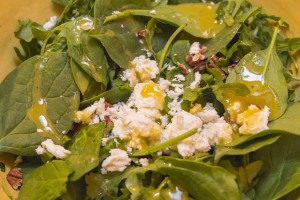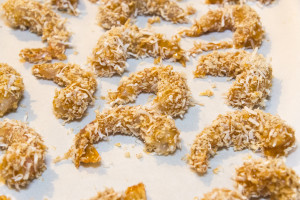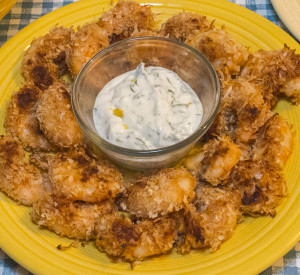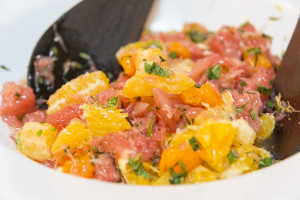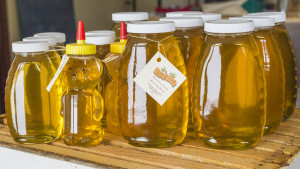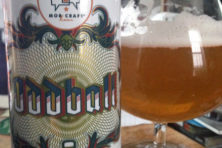Ancient Nectar of Gods
- Share
- Tweet
- Pin
- Share
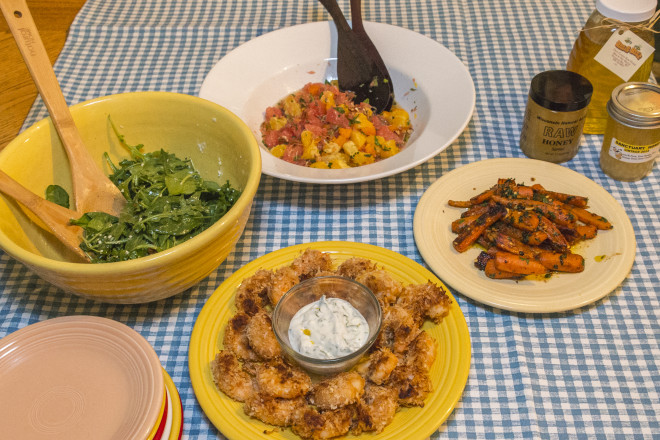
Honey has been written into historical documents in many world cultures as far back as 2100 B.C. It was the very first sweetener incorporated into food and drink. Not only was honey used in consumables it was also highly regarded as a currency in ancient times and used for its medicinal purposes. Honey has been called the nectar of the gods. It is versatile and adds complexity to your cuisine when substituted for traditional sugar. I love it in my coffee.
Raw local honey is readily available here in Door County. The majority of honey found in our region is wild clover – light in color and mild in flavor, which makes it versatile when incorporated into your kitchen practice.
I included examples of how to include honey into your everyday recipes. Sweet and savory. Enjoy!
Honey Mustard Salad Dressing
¼ cup extra virgin olive oil
2 Tbsp honey
2 Tbsp Dijon mustard
1 Tbsp apple cider vinegar
salt and cracked fresh pepper to taste
Mix all ingredients in canning jar. Cover jar with a lid, vigorously shake and pour over your favorite salad. Any extra dressing can be stored in your refrigerator for up to one week.
Pan Roasted Honey Dijon Carrots
Serves 4 as a side dish
1 lb. carrots cut into halves
1-2 garlic cloves sliced
2 Tbsp olive oil
splash of dry white wine (I used Southern Comfort out of desperation)
2 Tbsp butter
1 Tbsp Dijon mustard
2 tsp honey
handful fresh chopped Italian parsley
salt and pepper to taste
Optional: pinch of crushed red peppers added with the parsley.
Heat cast iron pan to high heat. Add olive oil, enough to cover the bottom of the pan. Add carrots, sauté for 2 to 3 minutes. Add white wine, honey and Dijon. Coat the carrots, reduce heat to simmer, cover and steam for 5 minutes. Remove cover, add garlic and continue tossing carrots until they are golden brown. Add parsley, crushed red pepper (optional), salt and pepper to taste.
Spicy Peanut Coconut Shrimp
Preheat oven to 450? F
You will need a parchment lined sheet pan.
1lb. raw shrimp – peeled, deveined, washed and dried (approx. 16-20 shrimp)
¾ cup panko
¾ cup unsweetened shredded coconut
sprinkle cayenne pepper
2 Tbsp peanut butter
1 tbsp honey
squirt of sriracha (chili sauce)
1 tsp tamari or soy
2 tbsp canola or grapeseed oil
Mix panko, shredded coconut and cayenne in a shallow bowl. Set aside.
In a separate bowl, whisk together peanut butter, honey, sriracha, tamari and oil. Dip the shrimp in the peanut butter mixture, then roll the shrimp in the coconut/panko breading. Place the breaded shrimp onto the prepared sheet pan. Continue until all shrimp are breaded. Bake in the preheated oven for approximately 15 minutes; flip half way through the bake time. Enjoy paired with the Cilantro Basil Yogurt Dip.
Cilantro Basil Yogurt Dip
8 oz. container plain Greek yogurt
1 Tbsp honey
chopped cilantro and basil (approx. 3 tbsp.)
juice of ½ lemon
salt to taste
Mix all ingredients together in a small bowl and let it sit for a half hour or more so the flavors blend together.
Fresh Ginger Citrus Chutney
Makes a very refreshing dessert or would be great on top of grilled fish or chicken.
1 clementine
1 orange
1 grapefruit
1 Tbsp honey
½ tsp grated ginger
3 Tbsp shredded fresh mint
salt
Optional: toasted pecans and shredded coconut
Peel, segment and remove the membranes on the citrus fruit. Toss in a bowl. Add the shredded fresh mint, honey, grated ginger (I use a microplane for this) and a tiny pinch of salt. Add toasted pecans and shredded coconut if you wish.
Substitute Honey for Sugar
Traditionally baking recipes are written to incorporate cane sugar as the sweetener. You can easily swap out honey for any recipe. Honey adds complexity and layers to whatever it is you are baking. It also has potential to decrease the sweetness and round out the flavors. Obviously, honey is liquid and cane sugar is not so you will have to consider that when making the substitution. Here are simple guidelines to follow from www.cooks.com.
Fructose levels are higher in honey than sugar, which means you will not need as much honey to get the desired sweetness.
Substitute 1 cup honey for 1 cup sugar for the first cup and then 2/3 cup honey for every additional cup of sugar substituted.
Reduce the baking temperature by 25?F, as honey browns faster than sugar.
Add a ¼ teaspoon of baking soda for each cup of honey added when baking soda is not already included in the recipe.
When substituting a cup or more of honey, reduce the liquids by ¼ cup to begin. Depending on the recipe you may have to experiment with this.

